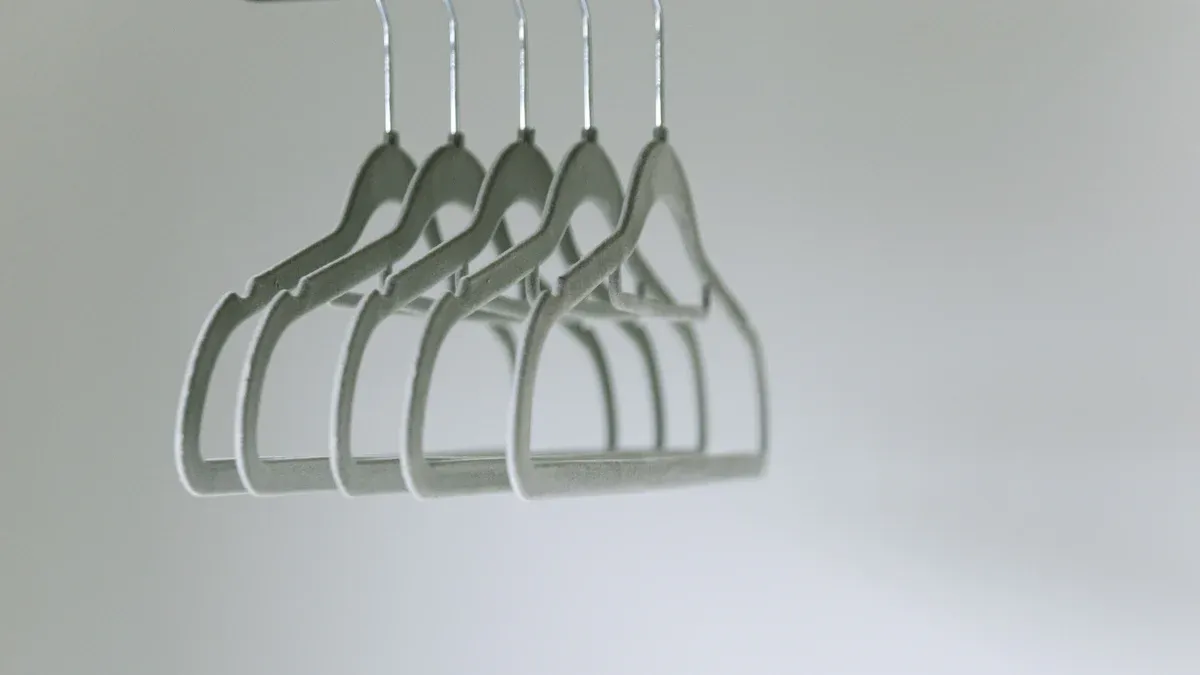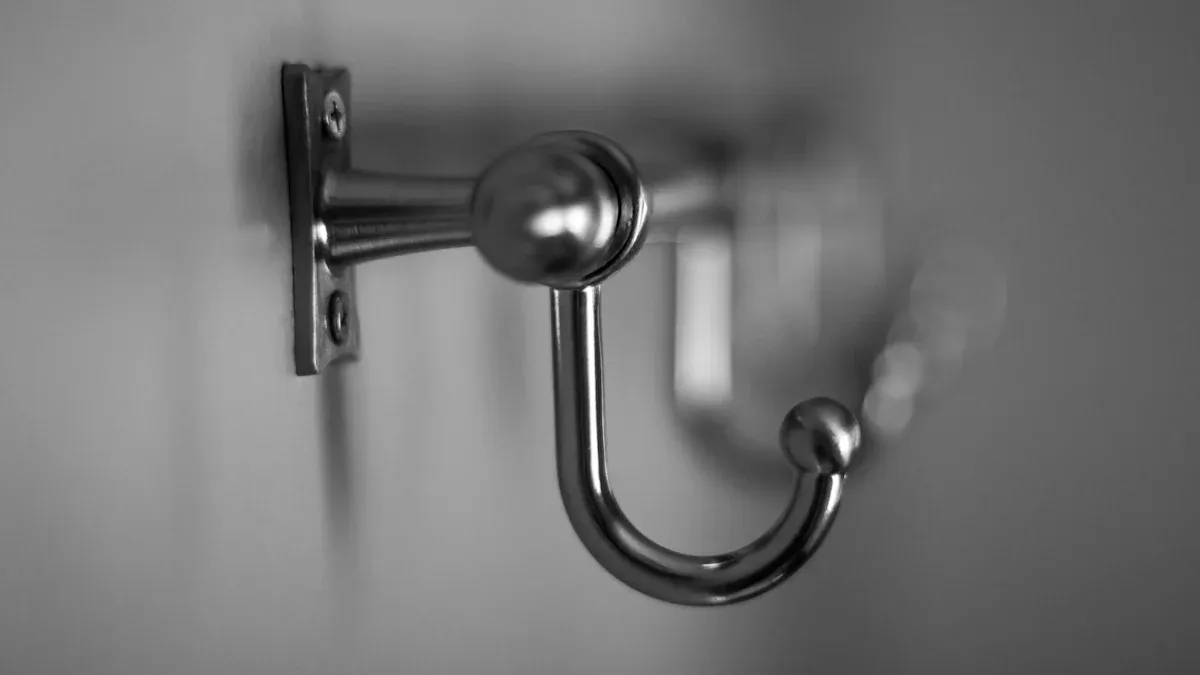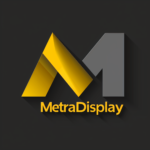
Metal display hooks serve as a vital tool for retailers aiming to optimize vertical space. By utilizing these hooks, businesses can significantly enhance product visibility and accessibility. Organized displays not only create a more appealing shopping environment but also encourage customers to explore more products. This strategic arrangement can ultimately drive higher sales and foster customer satisfaction.
Key Takeaways
- Metal display hooks enhance vertical space utilization, allowing retailers to showcase more products without taking up additional floor space.
- Durable and strong, metal display hooks support a variety of products, ensuring reliability and reducing the risk of damage.
- Versatile in design, these hooks can adapt to different retail environments and display systems, making them suitable for various product types.
- Positioning products at eye level increases visibility and encourages purchases, as this area is most accessible to shoppers.
- Grouping similar products on hooks simplifies the shopping experience, helping customers find what they need quickly and easily.
- Creating focal points with strategically placed hooks draws attention to specific items, boosting sales and enhancing store aesthetics.
- Regular maintenance of metal display hooks, including inspections and cleaning, ensures their longevity and effectiveness in retail displays.
- Choosing the right hooks based on product weight and store layout maximizes display effectiveness and improves customer engagement.
Benefits of Metal Display Hooks
Durability and Strength
Metal display hooks offer exceptional durability and strength, making them ideal for various retail environments. Retailers can rely on these hooks to support a wide range of products, from lightweight items to heavier merchandise. The robust construction ensures that hooks withstand daily use without bending or breaking. This reliability is crucial for maintaining an organized display and preventing product loss. Retailers can confidently showcase their inventory, knowing that metal display hooks will provide the necessary support.
Versatility in Use
One of the standout features of metal display hooks is their versatility. These hooks can adapt to different retail settings, accommodating various product shapes and sizes. Retailers can utilize them in:
- Supermarkets
- Pharmacies
- Sports stores
- Stock rooms
- Workshops
- Convenience stores
- Automotive stores
- Newsagents
Additionally, metal display hooks work seamlessly with various display systems, including pegboards, slatwalls, and gridwalls. This adaptability allows retailers to customize their displays according to their specific merchandising needs. For instance, hooks can be modified for flat pegboard use, ensuring that retailers can maximize their display potential.
Maximizing Vertical Space
Maximizing vertical space is essential for effective retail display. Metal display hooks excel in this area by allowing retailers to utilize wall space efficiently. By hanging products at different heights, retailers can create visually appealing displays that draw customers’ attention.
| Display System | Compatibility with Metal Hooks |
|---|---|
| Pegboard | Yes |
| Slatwall | Yes |
| Gridwall | Yes |
The ability to reposition hooks easily enables retailers to experiment with different configurations. This flexibility allows for the accommodation of various products, enhancing overall display effectiveness. Retailers can measure the impact of their vertical space utilization by observing increased product visibility and sales.
Enhancing Product Visibility
Metal display hooks play a crucial role in enhancing product visibility within retail environments. When retailers utilize these hooks effectively, they create displays that attract attention and engage consumers visually. Well-organized displays not only leave positive impressions but also increase the likelihood of purchases. Here are several ways that metal display hooks contribute to improved product visibility:
- Attracting Attention: Neatly arranged products draw customers’ eyes. Retailers can position items at varying heights to create a dynamic visual experience. This method encourages shoppers to explore the display further.
- Guiding the Eye: Shoppers tend to focus on the center of the shelf first. By aligning products neatly in rows, retailers make items more noticeable without needing additional signage. This organization reduces scanning time, leading to quicker purchasing decisions.
- Creating Positive Impressions: Effective visual merchandising enhances product presentation. Organized displays create perceptions of quality and value, which can significantly influence buying behavior. In fact, over 70% of purchasing decisions occur at the shelf display. Cluttered displays, on the other hand, can reduce shopper confidence, deterring purchases.
- Encouraging Impulse Buys: When products are visible and accessible, customers are more likely to make impulse purchases. Retailers can strategically place popular items at eye level to maximize their visibility and encourage spontaneous buying.
By leveraging the benefits of metal display hooks, retailers can create an inviting shopping atmosphere that enhances product visibility and drives sales.
Strategic Placement Techniques
Eye-Level Positioning
Positioning products at eye level is a fundamental strategy in retail merchandising. This area is the most accessible for adult shoppers, leading to increased visibility and attention. The principle known as “Eye Level is Buy Level” emphasizes that products displayed at this height are more likely to be noticed and purchased. Retailers can maximize vertical space by utilizing often underused areas in their stores. Here are some best practices for eye-level positioning:
- Highlight best-selling products by placing them at eye level to attract more attention.
- Maintain balance and spacing on display hooks to avoid clutter and ensure each product stands out.
- Products positioned between waist and eye level attract the most attention, making this area ideal for high-margin products and bestsellers.
| Evidence | Description |
|---|---|
| Eye Level is Buy Level | Products at eye level are more likely to be noticed and purchased, as this area is considered prime for visibility. |
| Visibility Impact | Products placed at eye level directly correlate to increased sales, as they are easier for customers to see and reach. |
By implementing these strategies, retailers can significantly enhance customer engagement and drive sales.
Grouping Similar Products
Grouping similar products on metal display hooks streamlines the shopping experience. This technique reduces decision fatigue by simplifying choices for customers. When products are organized systematically, they become easier to navigate. Retailers can employ several strategies to optimize product grouping:
| Strategy | Description |
|---|---|
| Systematic Arrangement | Ensures optimal product visibility and easy customer access. |
| Space Optimization | Maximizes retail floor space utilization through vertical merchandising. |
| Cross-Merchandising | Encourages additional sales by strategically placing complementary items. |
| Organizational Strategies | Enhances customer navigation through strategic product grouping. |
| Color-Coding Systems | Improves organization by implementing color-coded displays for easier identification of products. |
Grouping similar products not only aids in customer navigation but also guides consumers toward their preferred items. This organization enhances the overall shopping experience and can lead to increased sales.
Creating Focal Points
Creating focal points with metal display hooks can significantly impact store aesthetics and sales. Retailers can use strategic placement to draw attention to specific products or displays. For example, placing garment racks in high-traffic areas can increase visibility and sales by up to 30%.
- Metal display hooks enhance store aesthetics by providing a clean, modern look that allows clothing to stand out.
- They improve product visibility and create organized, visually appealing displays, which can attract customer attention.
- The reflective surfaces of metal hooks can enhance lighting effects, making displayed items appear more vibrant and appealing.
By focusing on these techniques, retailers can create an inviting atmosphere that encourages customers to explore and purchase.
Types of Metal Display Hooks

Standard Hooks
Standard hooks serve as the backbone of many retail displays. Retailers often use these hooks for their simplicity and effectiveness. They come in various sizes and styles, making them suitable for a wide range of products. Standard hooks typically attach easily to pegboards, slatwalls, and gridwalls. This versatility allows retailers to customize their displays based on specific needs.
Tip: When selecting standard hooks, consider the weight and size of the products. This ensures that the hooks can adequately support the merchandise without bending or breaking.
Specialty Hooks
Specialty hooks cater to specific product types or display needs. Retailers often choose these hooks for unique items that require special handling. For example, hooks designed for hanging clothing may feature notches to prevent garments from slipping. Similarly, hooks for accessories might have additional features like clips or loops to secure smaller items.
| Type of Hook | Price per Unit | MOQ | Special Features |
|---|---|---|---|
| Hookei Display | $0.01/set | 1 | Lowest entry cost, ideal for small needs |
| Hefei Restart | $0.05/pc | 10k+ | Best value for bulk, high review score |
| Xiamen Kainan (Kainice) | Higher price | N/A | Custom lengths, OEM capability |
| Foshan Fourgood | N/A | N/A | Hooks with price tag holders, chrome finish |
| Yiwu Yibiao and Ownway Display | N/A | N/A | Established suppliers with high ratings |
Retailers can enhance their displays by using specialty hooks that align with their product offerings. This approach not only improves organization but also elevates the overall shopping experience.
Adjustable Hooks
Adjustable hooks provide flexibility in display arrangements. Retailers can modify the height and angle of these hooks to accommodate different products and customer preferences. This adaptability is particularly beneficial in dynamic retail environments where merchandise frequently changes.
Note: Adjustable hooks can help retailers maximize vertical space. By repositioning hooks, they can create new displays without needing to invest in additional fixtures.
Retailers should consider their specific needs when choosing between standard, specialty, and adjustable metal display hooks. Each type offers unique advantages that can enhance product presentation and improve customer engagement.
Organizing with Metal Display Hooks
Categorizing Products
Organizing products effectively is crucial for enhancing the shopping experience. Retailers can utilize metal display hooks to categorize items systematically. This method maximizes space efficiency through vertical merchandising. By hanging products, retailers enhance visibility and improve accessibility. Neatly arranged items reduce clutter, creating a better shopping environment. Here are some effective ways to categorize products using metal display hooks:
- Small packaged items like snacks and cosmetics.
- Apparel and accessories such as socks and hats.
- DIY and hardware products including tools and screws.
- Electronics and tech accessories like cables and chargers.
- Pet supplies such as leashes and collars.
- Beauty and healthcare products including hair accessories and skincare items.
Retailers can position small accessories near checkout counters to encourage last-minute purchases. Placing seasonal items on eye-level hooks ensures they attract attention. Cross-merchandising can pair complementary products, creating themed displays that encourage multiple purchases.
Seasonal Displays
Seasonal displays play a vital role in retail strategy. Metal display hooks facilitate the creation of hotspots that attract customer attention, essential for showcasing seasonal items. Retailers can install high-level displays for seasonal stock, keeping them visible yet unobtrusive. Effective use of vertical space with metal hooks maximizes merchandise visibility, making it easier to rotate products. Here are some strategies for seasonal displays:
- Use hooks to highlight holiday-themed items prominently.
- Create visually appealing arrangements that reflect the season.
- Change displays regularly to keep the shopping experience fresh.
By implementing these strategies, retailers can engage customers and drive sales during peak seasons.
Rotating Stock
Regularly rotating stock is essential for maintaining customer interest and ensuring product freshness. Metal display hooks simplify this process. Retailers can easily reposition items to highlight new arrivals or seasonal products. This flexibility allows for quick adjustments based on inventory levels and customer preferences. Here are some best practices for rotating stock:
- Regularly assess inventory to identify slow-moving items.
- Use hooks to display new products prominently.
- Implement a schedule for changing displays to keep the store dynamic.
By effectively rotating stock, retailers can maintain a vibrant shopping atmosphere that encourages repeat visits.
Impact on Customer Experience
Improved Navigation
Metal display hooks significantly enhance customer navigation within retail spaces. By organizing products systematically, retailers create a clear path for shoppers. This organization reduces confusion and allows customers to locate items quickly. When products are displayed neatly, shoppers can easily identify what they need without feeling overwhelmed.
- Effective Layout: A well-structured display layout encourages customers to explore various sections of the store.
- Clear Signage: Using hooks to categorize products helps in guiding customers to specific areas, improving their overall shopping experience.
Retailers can also implement color-coding systems to further enhance navigation. By grouping similar items together, they simplify the decision-making process for customers. This approach not only saves time but also increases the likelihood of purchases.
Encouraging Impulse Buys
Metal display hooks play a crucial role in driving impulse buying behavior among customers. Retailers can strategically position products to trigger different types of impulse purchases:
- Pure Impulse: An unplanned purchase driven by emotion, such as spotting a limited edition item near checkout.
- Reminder Impulse: Seeing a product reminds the shopper they need it, like batteries displayed next to electronics.
- Suggestion Impulse: The shopper had no prior intention to buy but is convinced by product placement, such as a seasonal display of new skincare products.
- Planned Impulse: The buyer intends to purchase something but is influenced by promotions or bundling, like “Buy 2, Get 1 Free” deals.
By utilizing metal display hooks to showcase these items prominently, retailers can capture customer attention and encourage spontaneous purchases. The strategic placement of products at eye level or near checkout counters can lead to increased sales and enhanced customer satisfaction.
Creating a Welcoming Atmosphere
A well-organized retail space fosters a welcoming atmosphere that encourages customers to linger and explore. Metal display hooks contribute to this environment in several ways:
- They help organize smaller products effectively, maximizing available floor space.
- Enhanced product visibility encourages shoppers to browse more, leading to a more engaging shopping experience.
- A well-organized display can transform a simple pegboard into an attractive shopping area, making it more inviting for customers.
Using display hooks can lead to an enjoyable browsing experience. Shoppers are more likely to notice and pick up smaller items when they are neatly arranged. The organization of products on hooks creates a visually appealing layout that draws customers in, ultimately enhancing their overall shopping experience.
By focusing on these aspects, retailers can create an inviting atmosphere that not only attracts customers but also encourages them to return.
Maintenance and Care
Maintaining metal display hooks is essential for ensuring their longevity and effectiveness in retail environments. Regular care not only preserves their appearance but also enhances their functionality. Retailers should adopt a systematic approach to maintenance, focusing on inspections, cleaning, and timely replacements.
Regular Inspections
Retailers should conduct inspections of metal display hooks at least once a month. This frequency allows them to identify signs of wear, rust, or damage early. During inspections, they should look for:
- Corrosion: Check for any rust or discoloration that may indicate deterioration.
- Warping: Ensure hooks maintain their shape and can support products effectively.
- Breakage: Look for cracks or fractures that could compromise safety.
Additionally, tightening loose screws and lubricating moving parts can prevent further issues. Regular inspections help maintain a safe shopping environment and ensure that displays remain functional.
Cleaning Techniques
Keeping metal display hooks clean is vital for maintaining their appearance and preventing corrosion. Retailers should use safe cleaning substances such as white vinegar, baking soda, or mild dish soap. It is crucial to avoid chloride and abrasive cleaners, as these can damage the metal surface. Here are some effective cleaning techniques:
- Dusting: Regularly dust hooks to prevent buildup that can lead to tarnishing.
- Wiping: Use a damp cloth with a mild cleaning solution to wipe down hooks.
- Drying: Ensure hooks dry completely after cleaning to prevent moisture-related issues.
Implementing these cleaning practices can significantly extend the life of metal display hooks.
Replacement Guidelines
Despite regular maintenance, metal display hooks may eventually require replacement. Retailers should establish guidelines for when to replace hooks to maintain safety and functionality. Key indicators for replacement include:
- Visible Damage: Hooks that show significant wear or structural damage should be replaced immediately.
- Frequent Repairs: If hooks require constant repairs, it may be more cost-effective to invest in new ones.
- Changes in Inventory: As product lines evolve, retailers may need to adjust their display solutions to accommodate new items.
By adhering to these replacement guidelines, retailers can ensure that their displays remain safe and effective, ultimately enhancing the shopping experience for customers.
Choosing the Right Hooks
Assessing Product Weight
When selecting metal display hooks, retailers must assess the weight of the products they intend to showcase. Choosing hooks that can adequately support the weight of merchandise prevents accidents and maintains a professional appearance. For example, lightweight items such as scarves and jewelry typically weigh less than a pound, while medium-weight items like t-shirts and hats range from 1 to 5 pounds. Heavy items, including jackets and power tools, exceed 5 pounds.
To illustrate the weight capacity of various hooks, consider the following table:
| Product Number | Weight Capacity |
|---|---|
| 17053BN | 5 pounds |
| MR02-BN | 3 pounds |
| MR03-BN | 5 pounds |
| FC12-BN | 3 pounds |
| FC13-BN | 5 pounds |
| FC13-ORB | 5 pounds |
| 17081BN | 3 pounds |
| 17083BN | 5 pounds |
| 17200CLR | 1 pound, 3 pounds, 5 pounds |
Retailers should ensure that the selected hooks can support the weight of their products to avoid bending or breaking, which could lead to damaged merchandise.
Considering Store Layout
Store layout significantly influences the selection of metal display hooks. Retailers should strategically place hooks to optimize visibility and accessibility. For instance, positioning hooks at entry points can draw attention to seasonal promotions or new arrivals. In high-traffic aisles, hooks can enhance the visibility of best-selling items.
The following table outlines effective placement strategies:
| Placement Strategy | Description |
|---|---|
| At Entry Points | Draws attention to seasonal promotions, limited editions, or new arrivals. |
| High-Traffic Aisles | Positioned in corridors where shoppers naturally pass, enhancing visibility of best-selling items. |
| Checkout Zones | Displays low-cost items near cash registers to increase impulse purchases. |
| Eye-Level Advantage | Products at eye level can see 20% higher sales compared to those placed below the waistline. |
By considering these strategies, retailers can maximize the effectiveness of their displays and improve customer engagement.
Matching Hooks to Merchandise
To effectively match metal display hooks to specific types of merchandise, retailers should consider the product’s weight and size. This ensures safety and accessibility. Additionally, selecting hooks that align with the store’s brand style and display system compatibility is crucial.
The following table provides guidance on matching hook types to merchandise:
| Hook Type | Best For | Mounting System | Key Features |
|---|---|---|---|
| Pegboard Display Hook | Lightweight packaged items | Pegboard | Easy to reposition, ideal for small goods |
| Slatwall Display Hook | Apparel accessories, electronics | Slatwall panel | High flexibility, smooth appearance |
| Gridwall Display Hook | Fashion, sporting goods, tools | Gridwall | Strong hold, versatile layout |
Strategically placing hooks at eye level and in high-traffic areas enhances product visibility. By following these guidelines, retailers can create effective displays that attract customers and drive sales.
Metal display hooks play a crucial role in maximizing store space. They enhance organization and improve product visibility, making it easier for customers to find what they need. Retailers who implement these strategies often see increased sales as a result. When selecting hooks, it is essential for retailers to consider their specific needs to ensure optimal performance.
FAQ
What are metal display hooks?
Metal display hooks are fixtures used in retail environments to hang products. They optimize vertical space, enhance product visibility, and improve organization, making it easier for customers to find items.
How do I choose the right metal display hook?
Select hooks based on product weight, size, and store layout. Consider compatibility with display systems like pegboards or slatwalls. Ensure hooks match the merchandise for optimal support and visibility.
Can metal display hooks be used outdoors?
While some metal display hooks are suitable for outdoor use, retailers should choose hooks made from rust-resistant materials. This choice ensures durability and maintains appearance in varying weather conditions.
How often should I inspect metal display hooks?
Retailers should inspect metal display hooks at least once a month. Regular inspections help identify wear, rust, or damage, ensuring safety and functionality in the retail environment.
What types of products can I display with metal hooks?
Metal display hooks accommodate a wide range of products, including apparel, accessories, tools, and packaged goods. Their versatility allows retailers to showcase various items effectively.
How can I enhance product visibility with hooks?
Position products at eye level and group similar items together. Use hooks to create focal points and maintain organized displays. This strategy attracts customer attention and encourages purchases.
Are metal display hooks easy to install?
Yes, most metal display hooks are designed for easy installation. They typically attach to pegboards, slatwalls, or gridwalls without requiring specialized tools, allowing retailers to set up displays quickly.
How do I clean metal display hooks?
To clean metal display hooks, use a damp cloth with mild soap or vinegar. Avoid abrasive cleaners to prevent damage. Regular cleaning helps maintain appearance and prevents corrosion.

